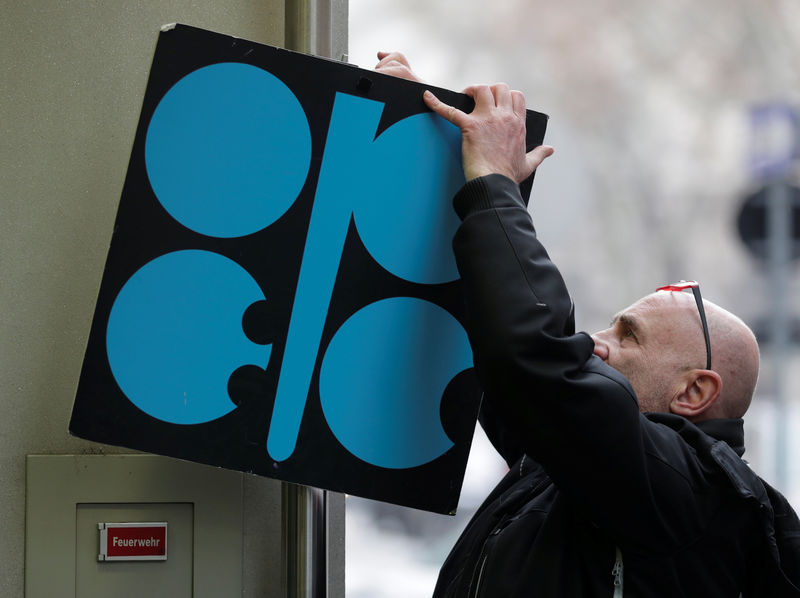 © Reuters. A man fixes a sign with OPEC’s logo next to its headquarter’s entrance before a meeting of OPEC oil ministers in Vienna
© Reuters. A man fixes a sign with OPEC’s logo next to its headquarter’s entrance before a meeting of OPEC oil ministers in ViennaBy Ernest Scheyder, Ahmad Ghaddar and Vladimir Soldatkin
VIENNA (Reuters) – OPEC and Russia look set to prolong oil supply cuts until the end of 2018 this week while signaling that they may review the deal when they meet again in June if the market overheats.
With oil prices () rallying above $60 per barrel, Russia has questioned the wisdom of extending existing cuts of 1.8 million barrels per day (bpd) until the end of next year as such a move could prompt a spike in U.S. production.
Russia needs much lower oil prices to balance its budget than OPEC’s leader Saudi Arabia, which is preparing a stock market listing for national energy champion Aramco next year and would hence benefit from pricier crude.
Six ministers from OPEC and non-OPEC oil producers including Saudi Arabia and Russia met in Vienna on Wednesday – one day ahead of a full OPEC gathering – and recommended extending the cuts to the end of 2018. At present, the cuts expire in March.
“That’s one of the recommendations,” Kuwait’s Oil Minister Essam al-Marzouq told reporters when asked whether the committee had agreed on a nine-month extension, among other matters.
Russian Energy Minister Alexander Novak was, however, less certain about the duration.
“The market has not been fully balanced yet. Joint efforts are needed after April 1. Everybody has recommended that the agreement could be extended and tomorrow such concrete details will be discussed,” Novak said.
Several sources familiar with the talks have said Russia had suggested an option of reviewing the deal at the next OPEC meeting in June in case the oil market overheats.
“In reality it would be only a three-month true extension with the review in June,” said Olivier Jakob from Petromatrix consultancy.
Benchmark Brent and prices traded flat on Wednesday after two days of declines, helped by a fall in U.S. crude stocks. [O/R]
Saudi Energy Minister Khalid al-Falih told the monitoring meeting on Wednesday that cuts needed to be extended as the rebalancing of oil markets was not yet complete.
Novak told reporters after meeting Falih: “We understand that we need to take further steps to rebalance the market … We have a common understanding (with Falih).”
Amrita Sen from consultancy Energy Aspects said she believed the debate between Saudi Arabia and Russia was about timings rather than substance.
“Saudi Arabia believes it is too early to discuss an exit strategy as the market rebalancing job hasn’t been done yet. Russia would like to do it sooner … OPEC has surprised on the upside during its past three meetings and delivered more than the market had expected,” she said.
DEBATE ON NIGERIA, LIBYA
Two sources familiar with OPEC talks said the group may debate capping Nigerian and Libyan output at 1.8 million bpd and 1 million bpd respectively, having exempted the two countries so far due to unrest and lower-than-normal production volumes.
The production cuts have been in place since the start of 2017 and helped halve an excess of global oil stocks although those remain at 140 million barrels above the five-year average, according to OPEC.
Russia has signaled it wants to understand better how producers will exit from the cuts as it needs to provide guidance to its private and state energy companies.
“It is important … to work out a strategy which we will follow from April 2018,” Novak told the monitoring committee.
Iraqi Oil Minister Jabar al-Luaibi said there had been little discussion so far on any exit strategy.
Some Russian producers including Rosneft, run by an ally of President Vladimir Putin, Igor Sechin, have questioned the rationale of prolonging the cuts, saying it will lead to a loss of market share to U.S. firms, which are not reducing output.
OPEC, which comprises 14 countries, has traditionally been much less worried about exit strategies as its members have been known for reducing compliance and cheating on their quotas towards the expiry of such deals.
“Russia seems to be pushing OPEC to have a concrete plan to phase out the cuts when appropriate … compared to the typical undisciplined OPEC strategy,” U.S. bank Tudor, Pickering, Holt & Co, which is active in the shale industry, said.
Source: Investing.com




























